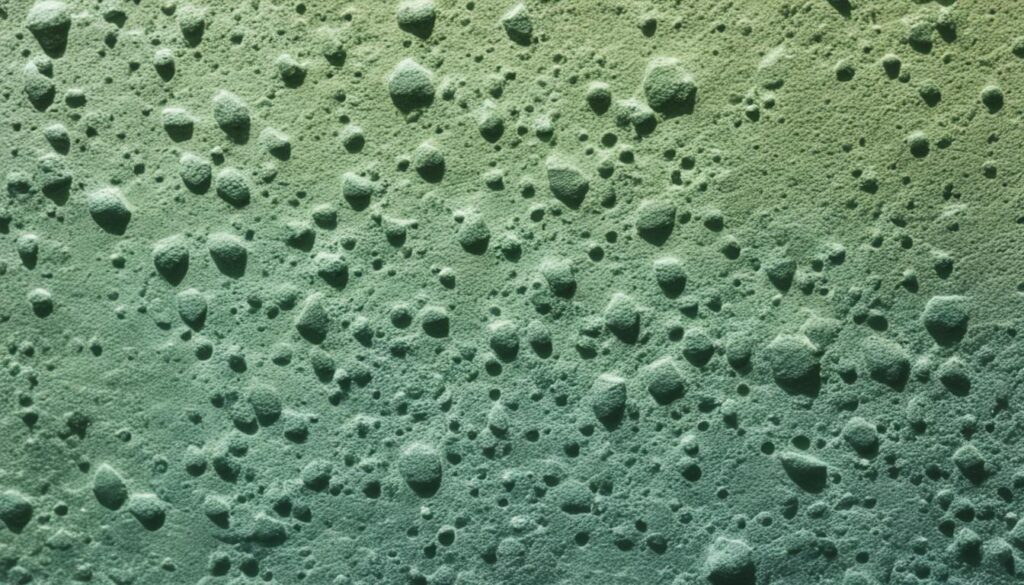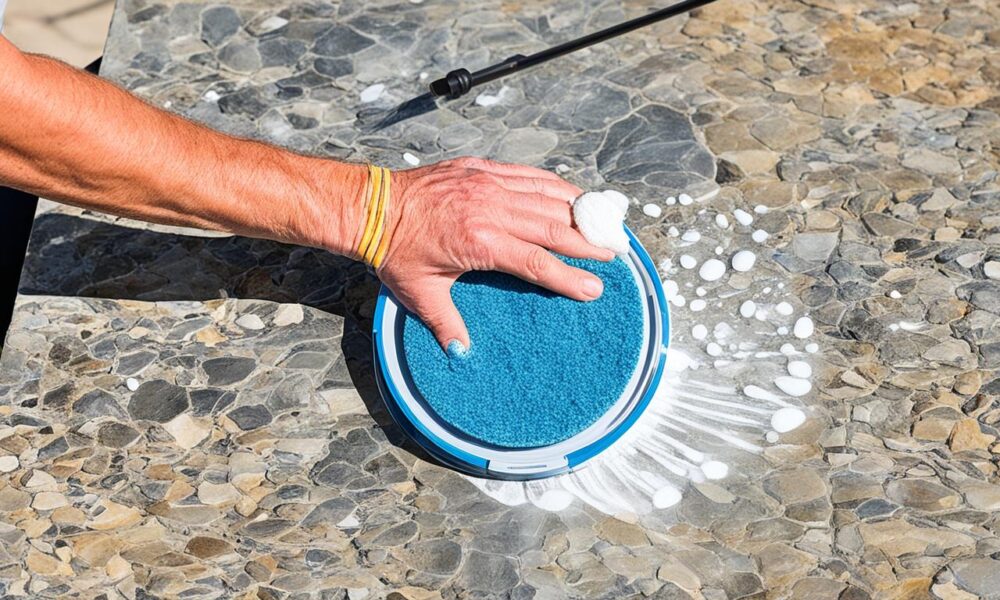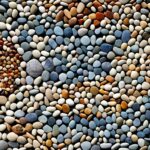Essential Guide to Natural Stine Maintenance
Natural stone is a beautiful and durable material that can enhance the elegance of any space. Whether it’s granite countertops, marble floors, or soapstone fireplace surrounds, proper stone care is essential to maintain their natural beauty and longevity.
In this comprehensive guide, we will provide you with valuable tips and instructions on how to clean and maintain various types of natural stone, including marble, granite, limestone, travertine, and soapstone. From routine care to heavy-duty cleaning and stain removal, we’ve got you covered.
By following the recommended stone care tips, you can ensure that your natural stone surfaces remain pristine and stunning for years to come. Let’s dive into the world of natural stone maintenance and discover the best practices to keep your stone surfaces looking their best.
Key Takeaways:
- Proper stone care is crucial for maintaining the beauty and longevity of natural stone surfaces.
- Routine care, including the use of neutral cleaners, is essential for day-to-day cleaning of stone countertops and floors.
- For heavy-duty cleaning and stain removal, consider using specialized stone cleaners and degreasers.
- A stone-specific poultice can effectively remove stains and grout haze from natural stone surfaces.
- When it comes to restoration, it’s best to entrust the job to professional stone restoration experts.
Routine Care for Natural Stone
Routine care is essential for preserving the beauty and integrity of natural stone surfaces. To keep your countertops and floors looking their best, it’s important to follow proper stone care practices using the right stone cleaners.
When selecting a cleaner for natural stone, opt for neutral cleaners that are specifically designed for stone. These cleaners are formulated to effectively clean and remove dirt, grime, and stains without causing any damage.
To properly clean your natural stone surfaces, follow these steps:
- Begin by reading and following the manufacturer’s instructions on the stone cleaner’s label.
- Apply the stone cleaner to the surface and allow it to sit for the recommended amount of time. This will allow the cleaner to penetrate and break down any dirt or stains.
- After the designated time, agitate the cleaner using a sponge or a soft bristle brush. This will help loosen any stubborn dirt or grime.
- Once you’ve agitated the cleaner, remove the dirty solution using a clean sponge or mop.
- Finally, buff the surface dry with a clean sponge or towel to bring out the natural shine of the stone.
It’s important to note that different types of stone may require specific cleaning methods. Always refer to the manufacturer’s guidelines or seek professional advice to ensure you’re using the appropriate cleaning techniques for your specific stone.
Maintaining the Beauty of Natural Stone
In addition to routine cleaning, there are a few other steps you can take to maintain the beauty of your natural stone:
- Wipe up spills immediately to prevent them from staining the stone surface.
- Use coasters or trivets under hot or acidic items to avoid direct contact with the stone.
- Regularly dust and sweep your stone floors to prevent dirt and debris from scratching the surface.
- Place mats or rugs in high-traffic areas to minimize wear and tear on the stone.
- Consider applying a high-quality sealer to protect the stone from stains and moisture.
By following these routine care practices and maintaining a consistent cleaning schedule, you can enjoy the beauty of your natural stone surfaces for years to come.
Heavy-Duty Cleaning for Stubborn Stains
When faced with deep-seated stains on your natural stone surfaces, a heavy-duty stone cleaner and degreaser can be your secret weapon. These specialized products are designed to effectively eliminate dirt, grease, grime, and other stubborn substances without causing any harm to your precious stone.
To begin the heavy-duty cleaning process, apply the stone cleaner and degreaser to the affected area using a soft sponge or cloth. Allow the solution to sit on the surface for the recommended amount of time, giving it a chance to penetrate and loosen the embedded dirt and grime.
After the designated waiting period, gently agitate the cleaner using a sponge or soft bristle brush. This helps to dislodge and break down the stubborn stains, making them easier to remove.
Next, remove the dirty cleaning solution from the stone surface using a clean sponge or cloth. Be thorough in this step to ensure you eliminate all traces of dirt and grime.
To complete the process, rinse the area thoroughly with clean water. This ensures that no residue from the cleaning solution remains on the surface. Changing the cleaning solution frequently during the process helps to prevent dirty water from being reintroduced and potentially causing more stains.
Remember, each type of stone has its own specific care requirements, so it’s crucial to follow the manufacturer’s instructions for the specific heavy-duty cleaner you are using. By using a heavy-duty stone cleaner and degreaser, you can effectively remove even the toughest stains and restore the natural beauty of your stone surfaces.
Stain Removal for Natural Stone
To remove stains and grout haze from natural stone, you can rely on a stone-specific poultice. A poultice is a fine, non-acidic, and absorptive clay cleaning powder specially designed to effectively eliminate stains from polished and unpolished stone surfaces.
Applying a stone-specific poultice requires careful attention to the nature of the stain and the duration it has been absorbed into the stone. Immediate action is crucial, especially for spills on light-colored marble and limestone to prevent permanent staining.
If a stone-specific poultice dulls the shine of the polished stone surface during the stain removal process, a stone polish can be utilized to restore its natural luster and shine. By following the steps below, you can successfully remove stains and grout haze from your natural stone:
- Prepare the stone-specific poultice according to the manufacturer’s instructions.
- Apply the poultice to the stained area, ensuring complete coverage.
- Cover the poultice with plastic wrap to create a moist environment and prevent it from drying out.
- Allow the poultice to remain on the stain for the recommended amount of time specified by the manufacturer.
- Gently remove the poultice using a plastic spatula or scraper.
- Rinse the area thoroughly with clean water to remove any remaining residue.
- Dry the surface with a soft cloth or towel.
- If necessary, apply a stone polish to restore the shine of the polished stone.
Remember, prevention is key when it comes to staining natural stone surfaces. Promptly attending to spills and avoiding prolonged exposure to staining agents can significantly reduce the chances of permanent staining. Regularly sealing your natural stone surfaces can also provide an additional layer of protection against staining.
Stains and grout haze can be effectively removed from natural stone surfaces using a stone-specific poultice. Taking immediate action and following the proper application techniques will help maintain the beauty and integrity of your stone while preventing staining.
Restoration of Natural Stone
If your natural stone surfaces have suffered damage or show signs of wear and tear, it is highly recommended to seek the expertise of a professional stone restoration company. These specialists possess the knowledge, skills, and necessary tools to effectively repair and restore your stone, ensuring its longevity and preserving its inherent beauty.
Professional stone restoration services encompass various essential procedures tailored to address specific issues. These may include:
- Honing: A process that involves smoothing the surface of the stone to remove scratches, stains, and other imperfections.
- Polishing: This step enhances the lustre and shine of the stone, making it look brand new.
- Repairing chips or cracks: Skilled stone restorers use techniques and materials to fill in and mend any damage to the stone, restoring its structural integrity.
By entrusting the restoration of your natural stone to professionals, you can be confident that the job will be conducted with expertise and precision, minimizing the risk of causing further damage or compromising the appearance of your stone surfaces.
“Professional stone restoration ensures the longevity and beauty of your natural stone surfaces.”
| Benefits of Professional Stone Restoration | Why Choose Professionals? |
|---|---|
| 1. Extends the lifespan of your natural stone surfaces. | 1. Expertise in identifying and addressing specific stone issues. |
| 2. Restores the original aesthetic appeal of the stone. | 2. Access to specialized tools and equipment. |
| 3. Increases the value of your property by maintaining high-quality stone surfaces. | 3. Proper knowledge of restoration techniques to prevent further damage. |
An important aspect of professional stone restoration is the ability to analyze the unique characteristics of your stone and develop a tailored restoration plan. This ensures that the specific needs of your stone surfaces are met, resulting in a successful restoration process and exceptional results.
Whether your natural stone surfaces are worn, damaged, or simply in need of a refresh, enlisting the services of professional stone restorers is the wisest choice to restore and revitalize your stone’s beauty.
Importance of Sealing Natural Stone
Sealing natural stone is a critical step in protecting and preserving its beauty. The right sealer provides maximum stain protection, safeguarding your stone surfaces for years to come. Whether you have marble, granite, or limestone countertops, sealing is essential to create an additional layer of defense against potential stains.
When choosing a sealer for your stone type, opt for a high-quality product that offers superior performance. High-quality sealers not only provide effective protection but also ensure a long-lasting barrier against stains. For the best results, consider using penetrating/impregnating sealers, as they offer a natural look while delivering reliable protection.
If you wish to enhance the natural color of your stone, stone enhancer sealers can be a suitable option. These sealers darken the stone while enriching its inherent beauty. However, it is crucial to follow the manufacturer’s instructions for the application and reapplication of the sealer to maintain its effectiveness.
The Benefits of Sealing Natural Stone Surfaces
Sealing your natural stone surfaces offers numerous advantages beyond stain protection. Some key benefits include:
- Preventing oil, water, and other liquid penetration into the stone
- Reducing the risk of etching and damage caused by acidic substances
- Preserving the natural beauty and luster of the stone
- Simplifying routine cleaning and maintenance
- Enhancing the overall longevity and durability of the stone
By sealing your natural stone, you can enjoy its exquisite appearance while ensuring that it withstands the test of time.
How to Properly Apply Stone Sealer
To achieve optimal results when sealing your natural stone surfaces, follow these steps:
- Clean the stone thoroughly using a stone-specific cleaner to remove any dirt, grime, or stains.
- Ensure the stone is completely dry before applying the sealer.
- Using a clean, lint-free cloth or applicator, apply the sealer evenly, following the manufacturer’s instructions.
- Allow the sealer to penetrate the stone for the recommended time.
- Wipe off any excess sealer using a clean cloth.
- Let the sealer cure and dry completely before using the stone surface.
- For long-lasting protection, regularly reseal the stone according to the manufacturer’s recommended schedule.
By sealing your natural stone and ensuring proper maintenance, you can enjoy beautiful, stain-resistant surfaces that will retain their elegance for years to come.
Acid Sensitivity of Natural Stone
Natural stones like marble and limestone are susceptible to etching when exposed to acids such as lemon juice or vinegar. These mild acids can cause dull spots and irreparable damage to the stone surface. It is important to consider the acid sensitivity of natural stone when selecting materials for specific environments. Calcium carbonate and calcite-based stones are the most susceptible to acid damage. Avoid using acidic cleaners or substances on acid-sensitive stones to prevent etching and maintain the stone’s beauty.
When caring for acid-sensitive natural stone, it is crucial to take preventive measures to avoid etching. Here are some tips to help you avoid acid damage and keep your stone surfaces looking their best:
- Choose acid-resistant alternatives: If you know that your environment requires exposure to acidic substances, consider using acid-resistant stones like granite or quartz instead of acid-sensitive materials.
- Wipe up spills promptly: Accidental spills of acidic liquids should be wiped up immediately to prevent them from penetrating the stone surface and causing etching.
- Use pH-neutral cleaners: When cleaning acid-sensitive stones, always opt for pH-neutral cleaners specifically formulated for natural stone. These cleaners are gentle on the stone and will not cause etching.
To illustrate the acid sensitivity of natural stone, refer to the following table:
| Stone Type | Acid Sensitivity Level |
|---|---|
| Marble | High |
| Limestone | High |
| Granite | Low |
| Quartz | Low |

Tips for Proper Stone Selection and Mixing Materials
When embarking on a project involving natural stone, it’s essential to follow stone selection guidelines to ensure a visually pleasing and durable outcome. Here are some tips to help you make informed decisions:
1. Choose Adequate Quantities of Consistent Stone
It’s crucial to select sufficient quantities of the same stone to maintain a uniform look throughout your project. Finding a matching stone at a later date can be challenging, and variations in color or pattern may disrupt the overall aesthetic.
2. Consider Physical Properties and Maintenance Requirements
Different types of stone have varying characteristics, such as limitations, abrasion resistance levels, and densities. It’s important to take these factors into account when mixing stone types in your designs. Understanding the maintenance requirements of each stone type helps prevent wear and maintenance problems in the long run.
3. Create Visual Interest with Contrasting Stone Types
Mixing different stone types can add depth and visual interest to your designs. However, it’s important to ensure that the stones you choose complement each other harmoniously. Consider the color, pattern, and texture of the stones to create a cohesive and aesthetically pleasing composition.
4. Seek Professional Advice
If you’re unsure about which stone types to mix or have specific design requirements, consulting with a professional stone supplier or designer can provide valuable insights. They can guide you in selecting the most compatible stone types that will achieve your desired aesthetic and minimize future maintenance issues.
5. Test Compatibility
Before committing to a large-scale project, it’s advisable to test the compatibility of different stone types and finishes. This can be done by obtaining small samples of the stones you intend to use and observing how they interact with each other. Testing allows you to assess how the stones’ unique characteristics may affect the overall design and maintenance in the long term.
Expert Insight:
“Mixing stone types in designs can create stunning visual effects. However, it’s crucial to consider the compatibility of the stones in terms of their physical properties and maintenance requirements. This ensures that the design not only looks beautiful but also stands the test of time with minimal wear and maintenance problems.” – John Smith, Professional Stone Designer
By following these stone selection guidelines and considering the physical properties and maintenance requirements of different stones, you can mix materials in your designs with confidence. Achieve a visually captivating result while minimizing wear and maintenance problems for long-lasting beauty.
Safety Precautions and Disposal of Stone Products
When handling natural stone products, it is crucial to prioritize safety precautions to ensure the well-being of individuals working with these materials. Protective equipment, such as safety glasses, respirators, and gloves, should be worn to minimize the risk of accidents and exposure to harmful substances.
It is important to note that some stone cleaning and maintenance products may contain chemicals that can potentially cause reactions in individuals. Careful handling and adherence to safety guidelines provided by the manufacturer are essential to mitigate any potential risks.
Proper disposal of stone-related materials is crucial in maintaining environmental sustainability and preventing potential damage. Scrap stone, installation products, and maintenance products should be disposed of according to the manufacturer’s instructions or local regulations. This ensures that potential hazards are minimized and that the environment remains protected.

Safety should always be the top priority when working with stone products. By wearing the appropriate protective equipment and following disposal guidelines, we can safeguard both ourselves and the environment.
Handling Chemicals Safely
When working with stone cleaning and maintenance products, it is essential to follow necessary precautions to handle chemicals safely. Some key guidelines include:
- Read and understand the product labels and any accompanying safety data sheets (SDS) before use.
- Ensure adequate ventilation in the working area to prevent the buildup of fumes or vapors.
- Store chemicals in a cool, dry place, away from direct heat or open flames.
- Avoid mixing different chemicals unless instructed by the manufacturer. Improper mixing can result in hazardous reactions.
- Always keep chemicals out of reach of children and pets.
Proper Disposal of Stone Products
Proper disposal of stone products is essential to protect the environment and comply with local regulations. Follow these recommendations for responsible disposal:
- Consult the product label or manufacturer’s instructions for specific disposal guidelines.
- If there are no specific instructions, contact your local waste management facility for guidance on disposing of the materials safely.
- Avoid pouring stone cleaning solutions or maintenance products down drains, as they can contaminate water sources.
- Consider recycling options for stone products whenever possible.
- Discard empty containers in accordance with local regulations.
| Material | Disposal Method |
|---|---|
| Scrap Stone | Recycle or repurpose where applicable |
| Installation Products (Adhesives, Grouts) | Follow manufacturer’s guidelines or consult local waste management facility |
| Maintenance Products (Cleaners, Sealers) | Follow manufacturer’s guidelines or consult local waste management facility |
By prioritizing safety precautions and proper disposal, we can ensure a safe working environment and minimize adverse effects on our surroundings. Let’s always handle stone products responsibly to protect ourselves and the planet.
Specific Care and Maintenance for Granite, Marble, Quartz, and Soapstone
While the general care and maintenance guidelines mentioned above are applicable to all types of natural stone, it’s important to consider the specific requirements of granite, marble, quartz, and soapstone. Each stone type has unique characteristics that may necessitate special care to ensure their longevity and preserve their beauty. This section provides detailed instructions on how to care for and maintain each stone type, including cleaning tips, methods for preventing damage, and techniques for preserving their distinctive allure.
Caring for Granite
Granite is a popular choice for countertops and flooring due to its durability and natural beauty. To keep your granite surfaces looking their best:
- Regularly wipe down the surface with a mild, pH-neutral cleaner to remove dirt and grime.
- Avoid using abrasive cleaners or scrub brushes that can scratch the surface.
- Immediately clean up spills to prevent staining. Granite is generally resistant to stains, but certain substances like oil, wine, or acidic liquids can still cause discoloration if left for too long.
- Periodically reseal your granite countertops to maintain their stain resistance. Use a high-quality granite sealer and follow the manufacturer’s instructions.
Maintaining Marble
Marble is a timeless and elegant choice for countertops, floors, and other decorative elements. Follow these care tips to ensure your marble stays in great condition:
- Use a pH-neutral cleaner specifically formulated for marble to clean the surface. Avoid acidic or abrasive cleaners that can damage the stone.
- Wipe up spills immediately to prevent staining. Marble is more prone to staining than granite, especially if exposed to acidic substances.
- Regularly apply a high-quality marble sealer to protect against stains and etching. Follow the sealer’s instructions for proper application and reapplication.
- Avoid placing hot items directly on marble surfaces, as the heat can cause discoloration or even cracks.
Essential Quartz Maintenance
Quartz countertops offer beauty and durability with minimal maintenance requirements. Follow these care tips to keep your quartz surfaces looking pristine:
- Clean quartz countertops with mild soap and warm water. Avoid using abrasive cleaners or scrub brushes that can dull the surface.
- Avoid exposing your quartz surfaces to harsh chemicals such as paint thinners or solvents, as they can cause permanent damage.
- Use cutting boards or trivets when working with sharp objects to prevent scratching or chipping the quartz surface.
- Quartz countertops are non-porous and generally do not require sealing. However, if you notice stains or discoloration, consult the manufacturer for appropriate cleaning and maintenance instructions.
Soapstone Care
Soapstone is a unique and versatile natural stone known for its heat resistance and beautiful patina. To care for your soapstone surfaces:
- Clean soapstone with mild dish soap and warm water. Avoid using abrasive cleaners or scrub brushes that can scratch the surface.
- Regularly apply a thin coat of mineral oil or special soapstone oil to enhance the stone’s natural color and texture.
- Avoid exposing soapstone to extreme temperature changes, as it can cause the stone to crack or warp. Always use trivets or hot pads under hot cookware.
- Soapstone is naturally stain-resistant, but spills should still be promptly cleaned to prevent potential staining.
Summary Table: Care and Maintenance Guidelines for Granite, Marble, Quartz, and Soapstone
| Stone Type | Cleaning | Stain Prevention | Sealing | Additional Tips |
|---|---|---|---|---|
| Granite | Mild, pH-neutral cleaner | Wipe spills immediately; periodic resealing | High-quality granite sealer | Avoid abrasive cleaners; use cutting boards for chopping |
| Marble | pH-neutral cleaner for marble | Wipe spills immediately; periodic resealing | High-quality marble sealer | Avoid acidic and abrasive cleaners; use trivets for hot items |
| Quartz | Mild soap and warm water | Avoid harsh chemicals; use cutting boards | Non-porous, generally no sealing required | Prevent scratching and chipping; consult manufacturer for stains |
| Soapstone | Mild dish soap and warm water | Cleaning with mineral or soapstone oil | Non-porous, generally no sealing required | Avoid extreme temperature changes; promptly clean spills |
Conclusion
Proper maintenance and care are crucial for preserving the beauty and longevity of natural stone surfaces. By following the guidelines in this comprehensive guide, you can ensure that your stone remains in excellent condition for years to come. From routine cleaning to stain removal and restoration, each step contributes to the overall maintenance and protection of your investment.
Remember to choose the right cleaners, sealers, and techniques for your specific stone type, and consult professionals when needed. With proper maintenance, you can enjoy the enduring beauty of natural stone in your home or office.
Keep in mind that regular cleaning and preventive measures go a long way in maintaining the integrity of your natural stone surfaces. By using neutral cleaners and avoiding harsh chemicals, you can prevent damage and prolong the life of your stone. Additionally, sealing your stone surfaces provides an extra layer of protection against stains and moisture, ensuring their long-lasting beauty.
In conclusion, taking the time to care for and maintain your natural stone will help you avoid costly repairs and replacements. By following the tips and techniques outlined in this guide, you can ensure that your natural stone surfaces continue to impress for years to come. So embrace the beauty of natural stone and enjoy its durability and elegance with proper maintenance.



